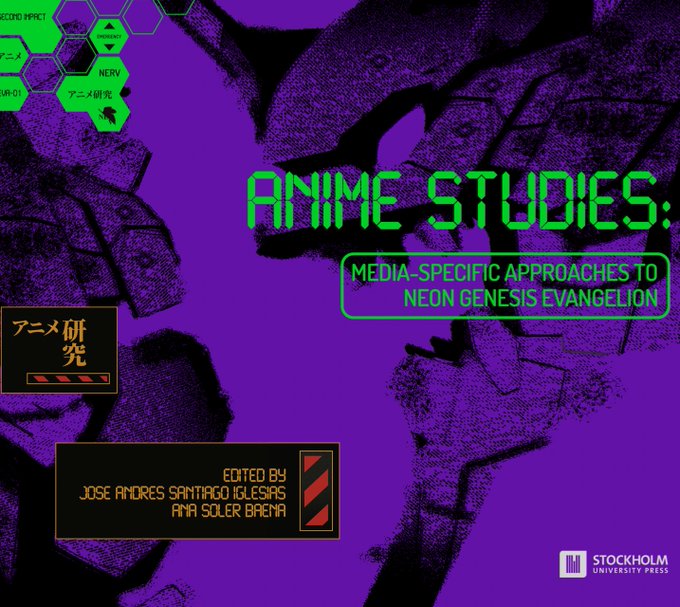Books: Approaches to Eva
December 12, 2021 · 0 comments
By Jonathan Clements.

Anime Studies: Media-Specific Approaches to Neon Genesis Evangelion is a delightful collection of fresh scholarship on all sorts of intriguing aspects of anime, as revealed through various angles to a famous and much-loved series, itself given a new lease of life and a new legion of fans thanks to Netflix. Published by Stockholm University Press, but organised out of the University of Vigo in Spain, it is a well-curated volume that will provide much food for thought for anime scholars and the more chin-strokey of fans.
You could, at least in theory, use any anime, or even any moment in an anime as a starting point to unpack the entire medium, at every part of the chain from Ownership to Access. But there’s a trick to picking the right one, and in the case of Evangelion, that would include its position as an acknowledged classic, a name-recognition title, an enduring property and precisely the sort of show that today’s young academics grew up as fervent fans of. However, it’s not that simple, as Jaqueline Berndt points out in her introduction.
Berndt is intricately precise over what the book is and isn’t, heading off a bunch of likely solecisms among the other authors before they can put their feet in it. She philosophises at length on the question of “what is anime?” not merely as a bout of academic throat-clearing, but also as a means of demonstrating how each of the chapters contributes a different nuance to that discussion, and making a strong and, I expect, influential case for the consideration of “Anime Studies” as a discipline separate from that of “Animation Studies.”
Notably, Berndt is not the editor of this collection. Instead, she seems to be a philosophical pinch-hitter, brought in by a young editorial team to knock the introduction out of the park before they can get back to getting on with stuff. The actual editors are Jose Andres Santiago Iglesias and Ana Soler Baena, the former of whom jumps in for the opening chapter, in which he concentrates on unmoving imagery, one of the most iconic elements of Evangelion, as agreed upon by both its fans and people who hate it. Yes, these authors have gathered together to write about Evangelion, but Santiago Iglesias pays it the compliment of not turning this into an excuse to simply gush about it non-stop. Instead, he accords equal consideration to whatever it is the haters want to hate.

Santiago Iglesias unpacks a series of moments in Evangelion where, in animation terms, literally nothing happens, not merely as cost-cutting measures, but as necessary trade-offs to re-assign funding to more action-packed scenes elsewhere, and even as deliberate artistic choices, or in terms of Hideaki Anno’s touchy relationship with the show’s fans. Here, he gets into “ratio dynamics,” that odd anime trade-off between movement and lack of movement, action and implied action, cost-cutting and cost-reassignment.
Whereas Santiago Iglesias zooms out from thirty uneventful seconds in a lift, Ida Kirkegaard zooms in on a chaotic, action-packed alarm scene in episode twenty-four. She does so in order to point out that the whole thing is composed of “bank cuts” – previously used shots, archived and then re-used. Poking around the shot numbers in the storyboards of Evangelion, Kirkegaard offers a compelling account of the making of a particular anime, zeroing in on fascinating new areas not a million miles away from Santiago Iglesias’s “ratio dynamics.” She reveals which bits of Evangelion used more recycled footage than others, and even some of the ways such repetition might have formed a subliminal function, such as the multiple recurrences of the same shot, along with the same music, that reinforced the notion of Misato’s apartment as a familiar and cosy “home.”

Kirkegaard is one of the most interesting young voices in anime academia, with an innovative approach to publicly available materials, and some surprising discoveries. Her deconstruction of Evangelion, for example, reveals that whereas the average superhero or transforming robot show uses bank cuts for action, Evangelion uses bank cuts in everyday life, in order to reallocate funds for more original action sequences. She wryly observes that when the Tokyo 3 control room is destroyed later in the series, “the characters relocate to a [heretofore] unmentioned secondary control center that just so happens to be identical to the original – and the same bank cuts are reused again.”
Using a method common in anime since Tezuka, Evangelion also “banked” a lot of its music, with Shiro Sagisu’s various themes being recycled at different points in the show. Heike Hoffer’s chapter observes that Sagisu’s music has escaped out into the world at large, and still occasionally crops up in unexpected places – news broadcasts, pachinko parlours and even as background music in furniture stores. But her interest is in one specific track, not by Sagisu but by Beethoven: “Ode to Joy” from the Ninth Symphony, which dominates Evangelion’s 24th episode. Hoffer explores the odd history of “Ode to Joy” in Japan, where it has come to be associated with the end of December – not for nothing, it is also the tune that closes Satoshi Kon’s Christmas movie Tokyo Godfathers – and the way in which its presence in the pivotal episode both recalls and amplifies the themes in the show itself. It is, after all, an anthem about all mankind becoming brothers, and “this kiss for the whole world,” in which a loving God offers salvation to the whole of humanity.

Minori Ishida writes about Megumi Ogata, the voice actress who plays Shinji, using her career as an excuse to delve into the entire super-structure of voice-acting, in every aspect from performance, to media profiles, to the law – it is, after all, the Japanese Child Welfare Act of 1947 that is partly to blame for the lack of children providing children’s voices in on TV, a particular issue for anime recordings, which can often be scheduled late in the evening, when children are literally not permitted to work. So, the deep-voiced Ogata gets to specialise in boys’ roles on Japanese television, although Shinji sounds markedly different in other countries – voiced by a man in the United States, by a woman in South Korea, a transgender actor on the new Netflix English dub… in fact, in only one territory, Brazil, is the voice of this 15-year-character actually provided by a 15-year-old boy! As Ishida notes, voice-work on Evangelion is particularly crucial because for the last two episodes of the original serial, it’s the voices alone that practically carry the show.
Other contributors include Stevie Suan on “embodied acting” and ecology, Jessica Bauwens-Sugimoto on Evangelion slash fiction, Olga Kopylova on the franchise and its fandom, Manuel Hernandez-Perez on “genre” and the various versions of the show created by changes in dub and music licensing. Zoltan Kacsuk asks why and how Evangelion has come to be considered such a game-changing anime at all. And on the subject of games, Selen Calik Bedir discusses the way in which the Evangelion franchise developed through its game spin-offs. This, too, is an intriguing direction, not the least because properly explaining what actually happens in Evangelion, as I once had to do for the Encyclopedia of Science Fiction, requires information that is only truly revealed in later PlayStation games. One hence feels a certain degree of sympathy for the brave Tatiana Lameiro-Gonzalez, whose mission in the closing chapter is to write a summary of the plot of Evangelion – a task which one suspects many of the original animators themselves would be hard-pressed to manage.
Jonathan Clements is the author of Anime: A History. Anime Studies: Media-Specific Approaches to Neon Genesis Evangelion is published by Stockholm University Press.
Leave a Reply